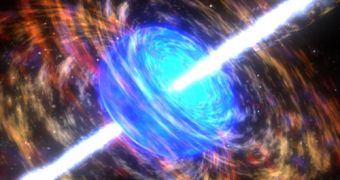Try taking a look at the night sky for a while, from time to time. It's kind of boring, isn't it? Nothing ever happens, there is peace and quiet everywhere you look. Or is it? Astronomers say the universe is a chaotic place, where massive explosions take place all the time in order to release large amounts of energy in the form of gamma-ray bursts, and there is nothing more violent that the emission of gamma-ray radiation. Nonetheless, no one seems to know what generates gamma-ray bursts, whether collisions between massive black holes or neutrons stars, or even the explosion of large stars.
The process of observing GRBs is made very difficult by the fact that they mostly occur in distant galaxies and are extremely short lived. In fact, they are so far away that the interactions which generated them could have taken place billions of years into the past. On the other hand, this is not necessarily a bad thing, because we can learn a great deal from universe's history, much in the same way we did with the human history.
NASA's Gamma-ray Large Area Space Telescope, or GLAST, will soon solve most of the problems related to catching the gamma-ray bursts before they quickly fade away. As with much of the scientific discoveries made over time, the gamma-ray bursts have been detected by mistake during the period of the cold war.
The U.S. army looking for eventual gamma-ray radiation, produced during the explosion of a test nuclear weapon, started detecting multiple bursts, but weren't able to pinpoint their place of origin anywhere on Earth. They quickly realized that the gamma-ray bursts were actually coming from space and started to study the phenomenon.
Since its opening back in the early 1990s, NASA's Compton Gamma-ray Observatory was able to detect over 2,704 distinct gamma-ray bursts, but could only associate to them about 400 new sources. On top of that, most of the gamma-ray emissions were found not to come from our galaxy, but from very distant regions of space in the universe.
An ordinary particle of light in the optical spectrum packs about 2 to 3 electron-volts of energy, while a gamma-ray photon could reach energies up to10 giga-electron-volts, a few billion times more than regular light.
GLAST is the first space observatory to make observations on gamma-ray bursts, and it will be able to detect photons at the highest energies possible with the help of the Large Area Telescope. It is generally predicted that when it will become functional, GLAST could detect and locate the source of about 50 gamma-ray bursts per year, while the Burst Monitor would only record emissions in the lowest spectrum of gamma-ray energy. By combining the data extracted from both detectors, scientists hope that they would be able to understand more about how gamma-ray bursts generated, in order to replicate the process in laboratory conditions to learn some new physical properties of matter.

 14 DAY TRIAL //
14 DAY TRIAL //